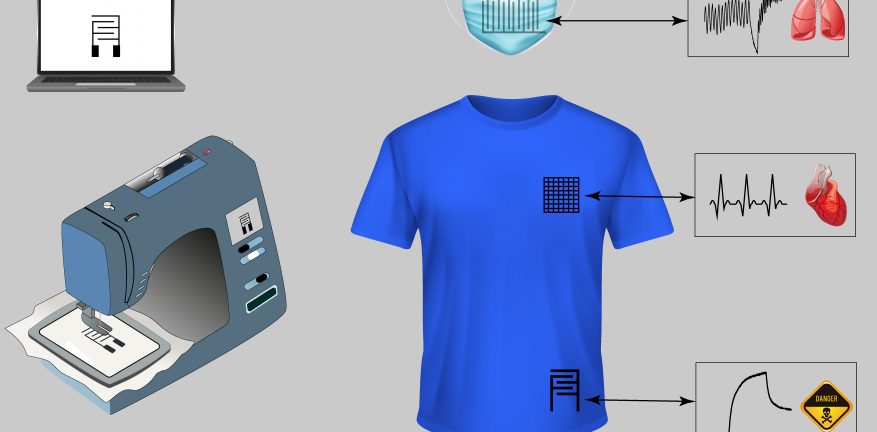
One can claim that wearable technologies originate from the 16th century, with the introduction of pocket watches. However, in my opinion, one of the first real wearable technologies was the watch that a mathematics professor, Edward Thorp, invented in the 1960s. A number of devices helped popularize and advance wearable technology over the following two decades. The first well-known was the calculator wristwatch, introduced by Casio. This watch can be seen in the picture below (Reliance Technology, 2019).

Nowadays, wearable technologies are becoming more and more adopted: smartwatches, fitness trackers, headphones, smart glasses, etc. Moreover, recent developments by researchers at Imperial college London could be a game changer. They designed a conductive thread suitable to embed sensors into pieces of clothing. The new thread, called PECOTEX, is revolutional because it is affordable, compatible with existing sewing machines, and fully waterproof, therefore machine-washable (Evans, 2022).
When thinking about the possibilities this technology brings, you are only limited by your imaginations. The first applications I could off were in terms of tracking: during fitness, when sleeping, but also for medical purpose tracking. That way, patients no longer have to wear visible machine on their body. They can just put on a t-shirt. Lastly, suppose GPS functionality can be embedded, parents could use these clothes to protect their kids when in an emergency (Evans, 2022).
Other developers in the field have presented similar research (Mulko, 2021), showing the potential of ‘smart clothes‘.
- Smart clothes could potentially cool you down when hot, and keep you warm when cold.
- Smart clothes could harvest energy: a human body radiates heat. This heat could be captured and could in the future be able to charge your phone on the go.
- Smart clothes could clean themselves, or at least disinfect your clothes. this is possible once the smart fibers are capable of sending out UV-C radiation.
References:
Evans, S. (2022, September 28). Researchers Design Conductive Thread to Embed Sensors Into Clothing. IoT World Today. https://www.iotworldtoday.com/2022/09/28/researchers-design-conductive-thread-to-embed-sensors-into-clothing/
Mulko, M. (2021, December 16). What is Smart Clothing Technology and How Does it Work?https://interestingengineering.com/innovation/what-is-smart-clothing-technology-and-how-does-it-work
Reliance Digital. (n.d.). Wearable Technology – Then & Now | | Resource Centre by Reliance Digital. Retrieved 3 October 2022, from https://www.reliancedigital.in/solutionbox/the-amazing-evolution-of-wearable-technology/

Hi David,
Interesting article! I think I’ve heard about embedded threads in clothing some years ago, but never anything (concrete) since then. The first thing that comes to my mind is the durability of these sensors. Do your sources, or if you know, mention anything about the durability of the sensors? Would they for example need careful handling as to not damage the sensors? Would sitting on the sensors in clothes or folding them damage the sensors?
-Loc Man
Hi Loc Man, thank you for your comment! That’s what I thought too, but that seems to be one of the main benefits of this new Pecotex. Their thread is very similar to regular thread. So it appears to be very durable. Also, because they say it is fully machine washable, I am inclined to believe them! Since in washing machines, the clothes will be thoroughly shaken around. However, I am curious to see how the product will perform in practice.
Hi David,
Very interesting article! I had never thought about the fact that clothes could have wearable technologies as well. I immediately started wondering about what type of company would be the first to introduce a technology like this and how many more years it will take before “smart clothes” are the new standard. Do you have any ideas on this? I am immediately thinking of a company like Nike that would be interested in implementing a technology like this, I am curious about your ideas!
– Floor
Hi Floor,
Thank you for your comment! I’m also very curious to see what the future of smart clothes will look like! I think that your idea of Nike is already a very good one. This would fit right in with their other products, considering they are one of the major sports clothes producers in the world, and they are also interested in technology to assist the people wearing them. Think about the Apple Watch for instance.
Another possibility might of course be that a start-up fully focuses on exploiting the technology. Eventually, companies like Nike could acquire the start-up if they’re interested, right?
Thanks again!
David
Hi David,
Thanks for the article. It is an interesting concept to design smart clothing. It sounds like it could provide many benefits. Just some questions that come to mind – Would people need to charge its smart t-shirt with solar energy? Or how would they make sure the sensors always work? I’m also thinking about radiation that comes off of these sensors. Would you assume these smart clothing to be safe in a health-way? Would love to hear your insights and opinion on these questions.
Hi Tessa,
Thank you for your comment. Some research has shown that the fibers could potentially be charged by using the heat radiated by the human body. So that would be even more amazing! That just wearing the t-shirt charges it. Especially for sport clothing, your body would get quite hot and the t-shirt wouldn’t have that much difficulty charging.
However, I do think that this stage of smart clothing is still very much into the future! So initially, maybe solar energy? I tried to research this a bit more, but I couldn’t really find anything about this.
And on the radiation of these sensors… I think the radiation will be similar to carrying your mobile phone, smartwatch, AirPods, with you all the time. That’s probably also not too good for you, however, commonly accepted. But I completely agree with you, these kind of sensors will be directly on your body, and perhaps in some cases all day long. This should be something that should be taken into account with great detail.